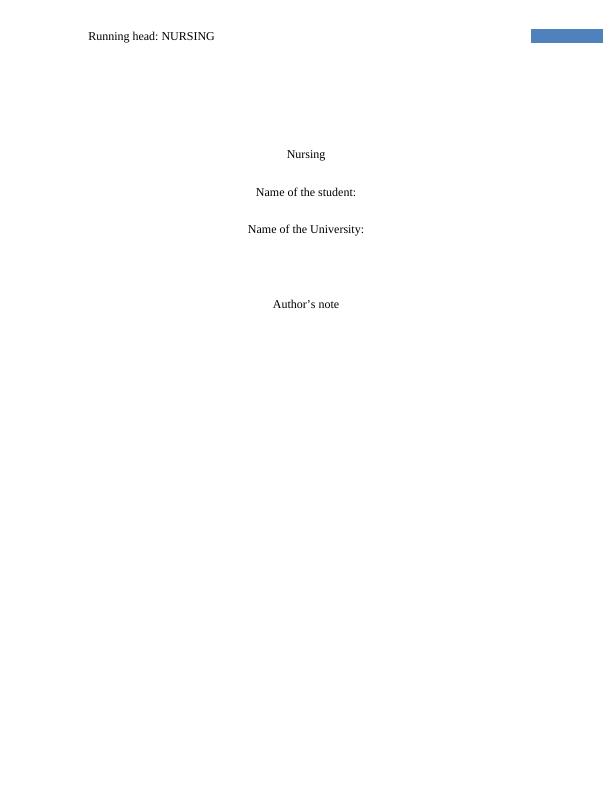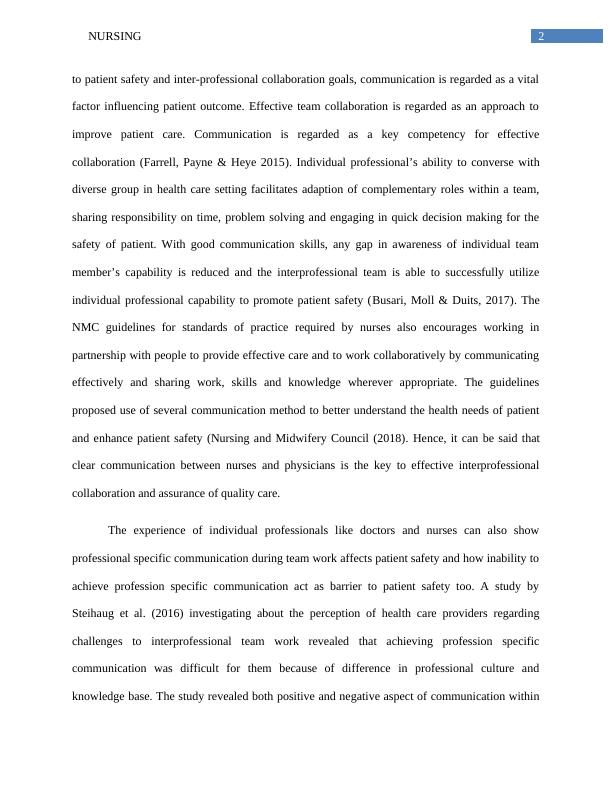Impact of Professional Identity on Patient Safety during Interprofessional Team Work
Added on 2023-06-03
12 Pages3167 Words145 Views
Running head: NURSING
Nursing
Name of the student:
Name of the University:
Author’s note
Nursing
Name of the student:
Name of the University:
Author’s note

1NURSING
Part a)
Introduction:
As the health care system is struggling with issues like shortage of health workers and
increase in disease burden, policy makers are introducing new strategies to bolster the global
health workforce (Sherwood & Barnsteiner, 2017). World Health Organization (2010) reports
about the Framework for Action on Inter-professional Education and Collaborative Practice that
provides strategies to successfully integrate collaborative team work within local health care
system. Inter-professional collaboration is one of the vital strategies within health care setting
that ensures fulfilment of various health care reforms and objectives. Effective team work and
inter-professional collaboration is linked to patient safety and improved patient outcome such as
reduction in medical errors, adverse drug reaction and decrease in mortality rates (Bosch and
Mansell, 2015). However, individual professional identities like specific skill and value plays a
role in influencing patient safety outcomes and inter-professional collaboration process. The
paper provides a detailed account into the impact of professional identity on patient safety by
focusing on the area of communication and leadership skill.
Impact of professional identity on patient safety during interprofessional team work:
Impact of profession specific communication on inter-professional team working and patient
safety:
Professional identity in health care is developed through the process of socialization and
individual staff’s professional identity determines how well inter-professional practice can be
executed in health care setting (Langendyk et al., 2015). A strong professional identity is
developed by the identification of core values of a chosen profession (Joynes, 2018). In response
Part a)
Introduction:
As the health care system is struggling with issues like shortage of health workers and
increase in disease burden, policy makers are introducing new strategies to bolster the global
health workforce (Sherwood & Barnsteiner, 2017). World Health Organization (2010) reports
about the Framework for Action on Inter-professional Education and Collaborative Practice that
provides strategies to successfully integrate collaborative team work within local health care
system. Inter-professional collaboration is one of the vital strategies within health care setting
that ensures fulfilment of various health care reforms and objectives. Effective team work and
inter-professional collaboration is linked to patient safety and improved patient outcome such as
reduction in medical errors, adverse drug reaction and decrease in mortality rates (Bosch and
Mansell, 2015). However, individual professional identities like specific skill and value plays a
role in influencing patient safety outcomes and inter-professional collaboration process. The
paper provides a detailed account into the impact of professional identity on patient safety by
focusing on the area of communication and leadership skill.
Impact of professional identity on patient safety during interprofessional team work:
Impact of profession specific communication on inter-professional team working and patient
safety:
Professional identity in health care is developed through the process of socialization and
individual staff’s professional identity determines how well inter-professional practice can be
executed in health care setting (Langendyk et al., 2015). A strong professional identity is
developed by the identification of core values of a chosen profession (Joynes, 2018). In response

2NURSING
to patient safety and inter-professional collaboration goals, communication is regarded as a vital
factor influencing patient outcome. Effective team collaboration is regarded as an approach to
improve patient care. Communication is regarded as a key competency for effective
collaboration (Farrell, Payne & Heye 2015). Individual professional’s ability to converse with
diverse group in health care setting facilitates adaption of complementary roles within a team,
sharing responsibility on time, problem solving and engaging in quick decision making for the
safety of patient. With good communication skills, any gap in awareness of individual team
member’s capability is reduced and the interprofessional team is able to successfully utilize
individual professional capability to promote patient safety (Busari, Moll & Duits, 2017). The
NMC guidelines for standards of practice required by nurses also encourages working in
partnership with people to provide effective care and to work collaboratively by communicating
effectively and sharing work, skills and knowledge wherever appropriate. The guidelines
proposed use of several communication method to better understand the health needs of patient
and enhance patient safety (Nursing and Midwifery Council (2018). Hence, it can be said that
clear communication between nurses and physicians is the key to effective interprofessional
collaboration and assurance of quality care.
The experience of individual professionals like doctors and nurses can also show
professional specific communication during team work affects patient safety and how inability to
achieve profession specific communication act as barrier to patient safety too. A study by
Steihaug et al. (2016) investigating about the perception of health care providers regarding
challenges to interprofessional team work revealed that achieving profession specific
communication was difficult for them because of difference in professional culture and
knowledge base. The study revealed both positive and negative aspect of communication within
to patient safety and inter-professional collaboration goals, communication is regarded as a vital
factor influencing patient outcome. Effective team collaboration is regarded as an approach to
improve patient care. Communication is regarded as a key competency for effective
collaboration (Farrell, Payne & Heye 2015). Individual professional’s ability to converse with
diverse group in health care setting facilitates adaption of complementary roles within a team,
sharing responsibility on time, problem solving and engaging in quick decision making for the
safety of patient. With good communication skills, any gap in awareness of individual team
member’s capability is reduced and the interprofessional team is able to successfully utilize
individual professional capability to promote patient safety (Busari, Moll & Duits, 2017). The
NMC guidelines for standards of practice required by nurses also encourages working in
partnership with people to provide effective care and to work collaboratively by communicating
effectively and sharing work, skills and knowledge wherever appropriate. The guidelines
proposed use of several communication method to better understand the health needs of patient
and enhance patient safety (Nursing and Midwifery Council (2018). Hence, it can be said that
clear communication between nurses and physicians is the key to effective interprofessional
collaboration and assurance of quality care.
The experience of individual professionals like doctors and nurses can also show
professional specific communication during team work affects patient safety and how inability to
achieve profession specific communication act as barrier to patient safety too. A study by
Steihaug et al. (2016) investigating about the perception of health care providers regarding
challenges to interprofessional team work revealed that achieving profession specific
communication was difficult for them because of difference in professional culture and
knowledge base. The study revealed both positive and negative aspect of communication within

3NURSING
an interprofessional context. Physiotherapist and occupational therapist revealed that limited
communication with nursing colleagues affected their rehabilitation work. Poor communication
with interprofessional team led to time consuming discussions and delay in making care plan
with patients. Hence, both interprofessional relationship as well as patient safety indicators is
affected if professional specific communication process is not accomplished by health care
professionals.
As difference in power and reluctance to start conversation has been identified as few
barriers affecting profession specific communication, there is a need to resolve this issue to
promote patient safety (Silvaggi, Nabhani-Gebara & Reeves, 2017). The contact theory is found
relevant to resolve the issue. It defines the appropriate condition under which inter-groups can
contact to reduce prejudice between majority and minority groups. The theory states that positive
effect of intergroup contact can occur only in four conditions which include intergroup
cooperation, support of authorities, equal group status within the situation and common goals
(Joyce, 2017). Hence, to facilitate profession specific communication within inter-professional
team, there is a need to modify the work culture and implement process that supports
implementing inter-professional collaboration effectively.
There are numerous evidences which show how poor inter-professional team
communication has an impact on quality outcomes of patient. Childress (2016) reports
miscommunication as the major reason behind medical errors and cites suboptimal
communication skills as the reason behind poor team communication and rise in negative patient
event. It cannot be denied that some of the health care setting may require unique communication
skills specific to the field to reduce patient injuries. For example, in an oncology setting team
members need to have strong communication to effectively share needs of patient with multiple
an interprofessional context. Physiotherapist and occupational therapist revealed that limited
communication with nursing colleagues affected their rehabilitation work. Poor communication
with interprofessional team led to time consuming discussions and delay in making care plan
with patients. Hence, both interprofessional relationship as well as patient safety indicators is
affected if professional specific communication process is not accomplished by health care
professionals.
As difference in power and reluctance to start conversation has been identified as few
barriers affecting profession specific communication, there is a need to resolve this issue to
promote patient safety (Silvaggi, Nabhani-Gebara & Reeves, 2017). The contact theory is found
relevant to resolve the issue. It defines the appropriate condition under which inter-groups can
contact to reduce prejudice between majority and minority groups. The theory states that positive
effect of intergroup contact can occur only in four conditions which include intergroup
cooperation, support of authorities, equal group status within the situation and common goals
(Joyce, 2017). Hence, to facilitate profession specific communication within inter-professional
team, there is a need to modify the work culture and implement process that supports
implementing inter-professional collaboration effectively.
There are numerous evidences which show how poor inter-professional team
communication has an impact on quality outcomes of patient. Childress (2016) reports
miscommunication as the major reason behind medical errors and cites suboptimal
communication skills as the reason behind poor team communication and rise in negative patient
event. It cannot be denied that some of the health care setting may require unique communication
skills specific to the field to reduce patient injuries. For example, in an oncology setting team
members need to have strong communication to effectively share needs of patient with multiple

End of preview
Want to access all the pages? Upload your documents or become a member.
Related Documents
Interprofessional Health Care Team - Essaylg...
|9
|2643
|102
An Introduction to Interprofessional Educationlg...
|15
|1812
|86
Case Study of Inter-professional Collaborative Practicelg...
|6
|1347
|60
Inter-Professional Collaboration and Teamwork in Health Care Organizations: A Nursing Perspectivelg...
|6
|1109
|298
Code of Ethics for Nurses in Australia | Essaylg...
|15
|3770
|34
Collaborative Nursing: Evidence-Based Practice and Interventionslg...
|8
|1894
|137
